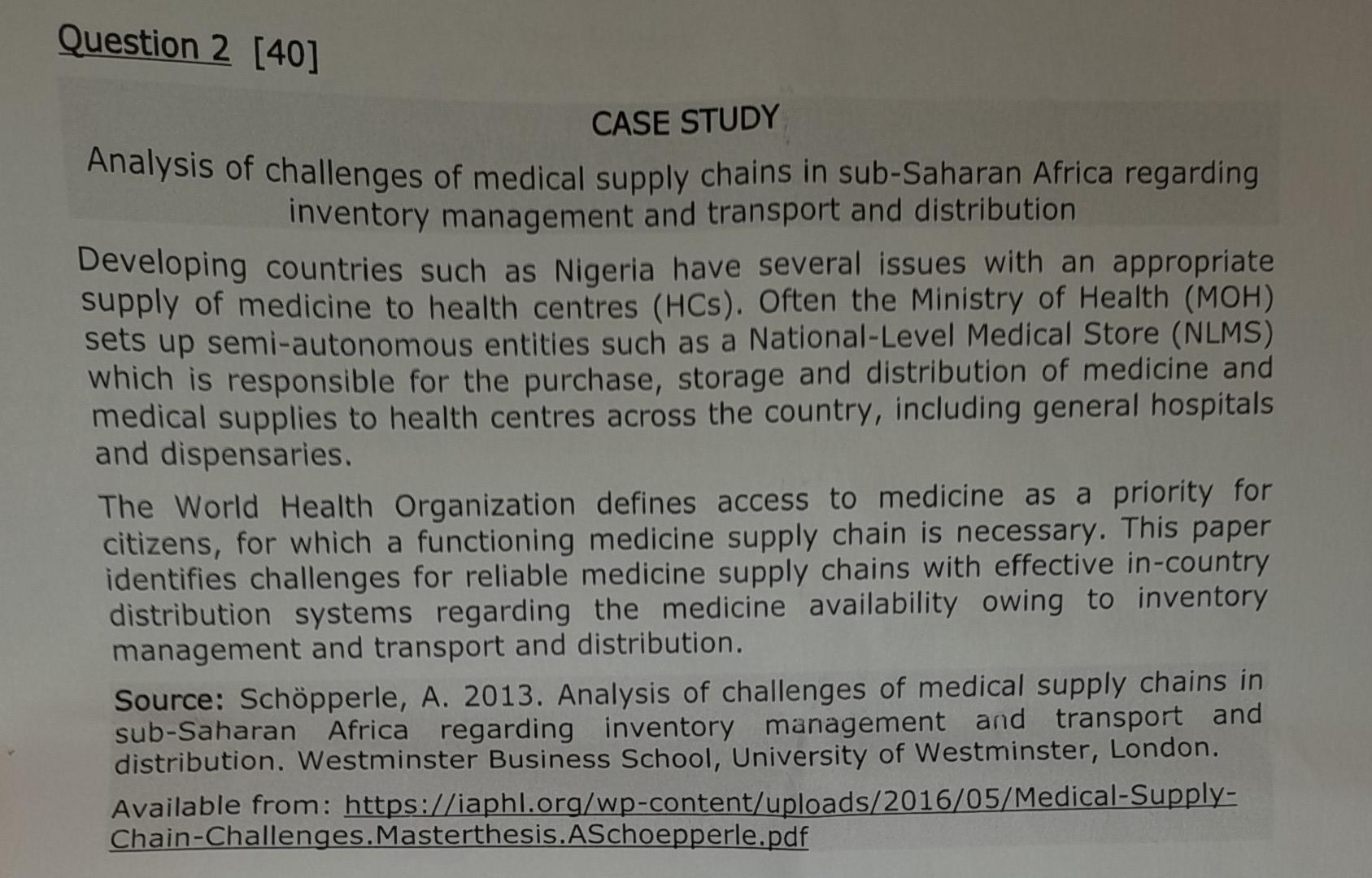Answered step by step
Verified Expert Solution
Question
1 Approved Answer
Question 2 [40] CASE STUDY Analysis of challenges of medical supply chains in sub-Saharan Africa regarding inventory management and transport and distribution Developing countries such


Question 2 [40] CASE STUDY Analysis of challenges of medical supply chains in sub-Saharan Africa regarding inventory management and transport and distribution Developing countries such as Nigeria have several issues with an appropriate supply of medicine to health centres (HCs). Often the Ministry of Health (MOH) sets up semi-autonomous entities such as a National-Level Medical Store (NLMS) which is responsible for the purchase, storage and distribution of medicine and medical supplies to health centres across the country, including general hospitals and dispensaries. The World Health Organization defines access to medicine as a priority for citizens, for which a functioning medicine supply chain is necessary. This paper identifies challenges for reliable medicine supply chains with effective in-country distribution systems regarding the medicine availability owing to inventory management and transport and distribution. Source: Schpperle, A. 2013. Analysis of challenges of medical supply chains in sub-Saharan Africa regarding inventory management and transport and distribution. Westminster Business School, University of Westminster, London. Available from: https://iaphl.org/wp-content/uploads/2016/05/Medical-Supply- Chain-Challenges. Masterthesis.ASchoepperle.pdf Download and read the published dissertation by Schpperle (2013) and then answer the following questions: 2.1 2.2 Summarise the typical challenges within the national health system's supply chain as identified in the dissertation and identify their consequences for the supply of medicine. (15) According to the author of the dissertation, vendor-managed inventory (VMI) is a concept that could be used in the public health sector. Answer the following questions about VMI: 2.2.1 Compare and contrast continuous replenishment programmes and vendor-managed inventories. (15) 2.2.2 Refer to the case study and identify the benefits and advantages that VMI would bring if it were to be implemented in the public health sector. (5) 2.2.3 Refer to the case study and identify the requirements for the successful implementation of VMI in the public health sector. (5) Question 2 [40] CASE STUDY Analysis of challenges of medical supply chains in sub-Saharan Africa regarding inventory management and transport and distribution Developing countries such as Nigeria have several issues with an appropriate supply of medicine to health centres (HCs). Often the Ministry of Health (MOH) sets up semi-autonomous entities such as a National-Level Medical Store (NLMS) which is responsible for the purchase, storage and distribution of medicine and medical supplies to health centres across the country, including general hospitals and dispensaries. The World Health Organization defines access to medicine as a priority for citizens, for which a functioning medicine supply chain is necessary. This paper identifies challenges for reliable medicine supply chains with effective in-country distribution systems regarding the medicine availability owing to inventory management and transport and distribution. Source: Schpperle, A. 2013. Analysis of challenges of medical supply chains in sub-Saharan Africa regarding inventory management and transport and distribution. Westminster Business School, University of Westminster, London. Available from: https://iaphl.org/wp-content/uploads/2016/05/Medical-Supply- Chain-Challenges. Masterthesis.ASchoepperle.pdf Download and read the published dissertation by Schpperle (2013) and then answer the following questions: 2.1 2.2 Summarise the typical challenges within the national health system's supply chain as identified in the dissertation and identify their consequences for the supply of medicine. (15) According to the author of the dissertation, vendor-managed inventory (VMI) is a concept that could be used in the public health sector. Answer the following questions about VMI: 2.2.1 Compare and contrast continuous replenishment programmes and vendor-managed inventories. (15) 2.2.2 Refer to the case study and identify the benefits and advantages that VMI would bring if it were to be implemented in the public health sector. (5) 2.2.3 Refer to the case study and identify the requirements for the successful implementation of VMI in the public health sector
Step by Step Solution
There are 3 Steps involved in it
Step: 1

Get Instant Access to Expert-Tailored Solutions
See step-by-step solutions with expert insights and AI powered tools for academic success
Step: 2

Step: 3

Ace Your Homework with AI
Get the answers you need in no time with our AI-driven, step-by-step assistance
Get Started


